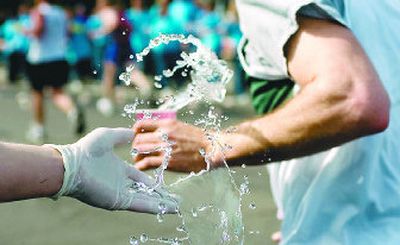SPRING IN THEIR STEPS

Mbarak Hussein had heard about the notorious hills of the annual Lilac Bloomsday Run. But after twice finishing in the top five of the Boston Marathon – a race also known for punishing hills – the 42-year-old runner from Albuquerque, N.M., didn’t think the short, little race in Spokane was anything to worry about.
After finishing his first Bloomsday, though, his mind had changed.
“Doomsday is a merciless hill,” said Hussein, who won the men’s masters category. “This is a very tough course.”
The race was also tough for the other 40,322 racers of the 31st Bloomsday who crossed the finish line, even if most of the racers and walkers took three or four times longer than Hussein.
The number of registered participants, 44,179, was down by about 500 from last year, but the deficit was more than overcome by the larger crowds of spectators and racecourse revelers. Compared with last year’s near-record low temperatures, Bloomsday 2007 enjoyed prime running weather: mid-50s, light breeze, lots of sun.
Apart from a finish line heart attack, there were no reports of major injuries or problems during the race, according to police and race officials. The heart attack was suffered by a 67-year-old man, who collapsed at the finish line. His heart stopped beating and he was clinically dead, though quick work by emergency medical workers saved his life and had the man breathing again, said Assistant Fire Chief Brian Schaeffer.
“We had one fatality, but we reversed it,” Schaeffer said, describing the heart attack.
The only record broken during the 7.46-mile race was Santiago Sanz-Quinto’s 32 minute, 44 second finish in the T-2 quadriplegic wheelchair category. Overall, this year’s wheelchair racing was as exciting and close as race official Tom Cameron has seen.
The wheelchair portion began with one of the top racers, Alfonso Zaragoza, of Mexico, nearly crashing, thanks to a racecourse pothole. Zaragoza recovered, but he never regained his early lead.
The excitement came from the intense competition between nine-time winner Saul Mendoza and Krige Schabort. The wheelchair race, like the foot races, is often decided on Doomsday Hill, but Mendoza and Schabort remained neck and neck up the hill.
Cameron, the organizer, watched the competition from the pace truck.
“I haven’t seen this in 20 years,” he said. “This is exciting!”
Schabort finished less than a second behind Mendoza, who earned his 10th win.
Bloomsday also served as the first venue for a collegiate wheelchair road race, fielding teams from the University of Illinois and University of Arizona.
“It’s a great race, but a little on the dangerous side because of the hills,” Pete Hughes, an official with the University of Arizona team.
Wheelchair racer Adam Bleakney, who coaches the University of Illinois team, brought a half-dozen of his team members to town, and together they entered their first Bloomsday.
His take on the course?
“It’s tough, challenging and very technical. You reach very high speeds downhill, and they seem to go by so fast. Then you seem to be climbing for, oh, about eight months,” he said with a weary smile. “I was excited to see the vulture at the top.”
Veteran marathon runner and first-time Bloomsday participant Rachel Toor said the hills were noteworthy, but it was the show along the course that made the race memorable. Along with bluegrass, blues, country, funk, rock and soul bands, a handful of political groups lined the sidewalks, including peace activists and several people advocating the decriminalization of cannabis.
“You can get a good bead on the city from a race,” said Toor, who recently moved to Spokane to teach at Eastern Washington University. Toor sped through the course, then decided to run it again at a slower pace to better appreciate the entertainment.
David Kwan, of Walla Walla, also ran the race for the first time Sunday. “I needed a reason to exercise,” he said, explaining his motivation for making the drive to Spokane.
Mayor Dennis Hession and his wife, Jane, completed somewhere between their 20th and 25th race – after so many, they lost count, Jane Hession said. Did the Hessions run or walk?
“We ran it, in a matter of speaking,” Jane Hession said. Their finish times were somewhere in the range of an hour and 40 minutes. They weren’t keeping close track. Like most others, they were just out to enjoy a sunny Sunday morning in May.